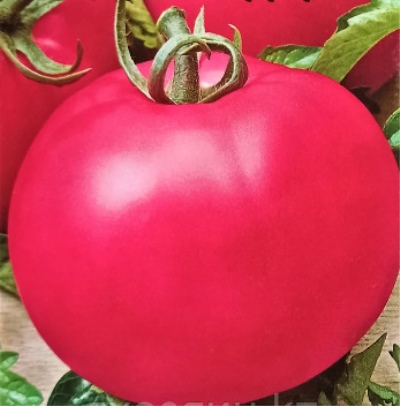
- Authors: Kondratieva I.Yu., Kandoba E.E., Pavlov L.V.
- Year of approval: 2007
- Category: grade
- Growth type: determinant
- Appointment: fresh consumption
- Ripening period: late ripening
- Growing conditions: for open ground, for film greenhouses
- Leaves: medium, dark green
- Unripe fruit color: light green
- Ripe fruit color: raspberry
Domestic development - the tomato variety Malinka - was bred not so long ago, but its bright raspberry, beautiful, sweet tomatoes have already become a welcome guest on the table and in the bins of Russian summer residents.
Breeding history
Breeding work on the creation of the Malinka variety was carried out on the basis of the Federal Scientific Center for Vegetable Growing in the person of its experienced employees - breeders Irina Yurievna Kondratyeva, Elena Evgenievna Kandoba under the leadership of Leonid Vasilyevich Pavlov. An application for permission to use was submitted in 2006, and a year later, in 2007, it was approved, the variety was included in the State Register of the Russian Federation for cultivation both in open ground and under a film cover.
Description of the variety
Tomato variety Malinka is a standard, determinant and therefore compact plant with a maximum height of bushes from 40 centimeters to half a meter. The leaves on them are of medium size, painted in a dark green tint. The inflorescences are simple, the fruit has an articulated peduncle. A number of positive qualities of the culture in question can be noted:
- simultaneous fruiting, which is very convenient when harvesting;
- maximum fruit set;
- high commodity indicators - even, identical fruits;
- excellent taste;
- transportable grade;
- high resistance not only to cracking of berries, but also to many diseases.
The main qualities of the fruit
Malinka tomatoes are distinguished by their perfect round and smooth shape. Unripe berries, like many other nightshade fruits, are green in color, in this case light green. Fully ripe tomatoes are expected to have a raspberry berry color that sets them apart from other tomatoes.
The size is small, but not small - an average of 100 to 130 grams. The number of seed nests is 6 or more. The fruits do not crack.
Taste characteristics
The name Malinka refers not only to the color, but also to the taste of the fruit: the tomatoes are quite sweet and juicy. The pulp of the berries is grainy, tender, and has a pleasant aroma. You can use vegetables for every taste - both for summer fresh salads and for preparations for the winter, pickles, canning. In all forms, they will be tasty and healthy.
Ripening and fruiting
The culture in question is considered late maturing. In some sources, however, it is attributed to mid-season varieties, which differ in a growing season of 110-120 days.
Yield
The Malinka variety, probably, cannot be called a high-yielding one, but a crop with abundant fruiting is possible. 3 kilograms of identical fruits are removed from one "square".
The timing of planting seedlings and planting in the ground
Since Malinka is grown both in the open field and in the greenhouse, seeds are traditionally planted for seedlings first. Experts do not indicate any special schedule, so you can adhere to the traditional scheme for mid-season varieties.

Growing tomato seedlings is an extremely important process, because it largely depends on whether the gardener will be able to harvest at all.All aspects must be taken into account, from seedbed preparation to planting in the ground.
Landing scheme
As for the planting conditions, the plant is small, so it would be logical to plant Malinka by analogy with other similar varieties. That is, no more than 3-4 plants per square meter.

Growing and care
The culture is unpretentious in care and cultivation. It is absolutely not required to pinch it, and also to shape it. Due to the low height of the bushes, a garter is also not needed. The rest of the care is no different from other varieties of tomatoes. It includes regular watering, loosening, mulching, fertilizing and other activities.




A plant needs different micronutrients at each stage of growth. All fertilizers can be divided into two groups: mineral and organic. Folk remedies are often used: iodine, yeast, bird droppings, eggshells.
It is important to observe the rate and period of feeding. This also applies to folk remedies and organic fertilizers.
Disease and pest resistance
One of the essential advantages of the variety is its excellent immunity, which was originally developed by breeders in this culture. This is resistance to top rot, root rot, powdery mildew, as well as such a rare ailment as corking of roots.


Growing regions
The Malinka variety has been zoned for cultivation from various regions of our country.These are such regions as the Central Black Earth Region, Central, North, North-West, Volgo-Vyatka. And also the North Caucasus, the Volga region, the Urals, all of Siberia and the Far East are not forgotten.

























































































